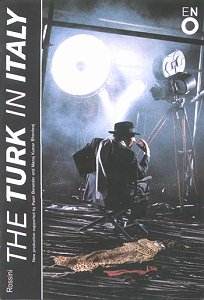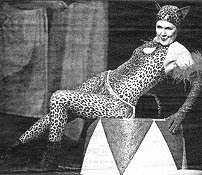This is the tale of how 'real' characters are propelled into action by a 'puppetmaster' and turned into stage figures to suit his purpose.
This is the tale of how these characters are manipulated by an operatic team and turned into cinematic figures to give these themes a modern guise.
This is the tale of how Il Turco in Italia became Il Turco di Londra and of how the subject of manipulation also became the object of the exercise.
Il Turco in Italia was first seen in 1814 in Milan. Rossini collaborated with the librettist Felice Romano to produce 'a sophisticated chamber opera', 'a finely-honed', 'an elegant, ambiguous somewhat cynical comedy' - to borrow Richard Osborne's words in the program book. It was staged as such by Broomhill Opera at Horsham in Sussex under the direction of Simon Callow in 1997, and that production is fondly remembered for its integrity and its ingenious and inventive triumph over financial constraints.
There are Mozartian over- or under-tones to this work, and its theme of manipulation of human beings brings to mind Cosi fan tutte. An important subtext to the Turk (as in Cosi) is an illustration of how to bring a straying, inconstant woman to heel. The title 'The Capricious Woman Corrected' was applied to this opera briefly. However, whereas Don Alfonso in Cosi provokes rather uncomfortable and uncertain end results, Rossini allows for redemption and the possibility of a more optimistic happy-ever-after.
In 19th century Europe, the Turkish Empire was perceived both as a fascinating foreign entity and as a threat (the echoes sadly linger on into our age of Balkan wars). Il Turco in Italia can also be seen as one attempt of many in 19th century culture to control the fear of the infidel, the other, through incorporation as a comic figure.
On the face of it an up-dating of this opera's themes, to make them meaningful and easily accessible to a contemporary audience through a link with the familiar world of cinema, seems promising.
Kit Hesketh-Harvey has produced a new version of the libretto to suit this vision. The transformation of the original is as manipulative of its object as the 'theatre/film director' (Thomas Allen) is of his character in the opera. Manipulation is the name of the game and would be reasonable if part of the serious edge were not lost, or smothered by cheap and easy laughs.
The period setting of the action in the Cinecitta of Fellini, along with such jokes as Omar Shariff as the idol of Zaida the masseuse (Victoria Simmonds), gives this production a curiously dated feel, and lacks the sophistication of Fellini films. An allusion to Tommy Cooper produced some knowing laughs but some members of the audience were puzzled. The text seems to address an over 60's British public.
More importantly, there seems to be some jarring in the use of the modern mode of film production to illustrate the conventions appropriate to music theatre. To have Geronio, the humiliated husband/producer (Donald Maxwell), lamely moving around with gun in hand, seemingly for ever, whilst the action is slowly unfolded musically and vocally, confounds the dramatic logic of opera with that of the cinema. Their pacings are different.
The filmic sets fitted almost unobtrusively into the Lazaridis stage setting, but neither contributed much to, or counterpointed, the other.
This Turk in Italy has collected a mixed bag of verbal and visual jokes in London, and it is luckily carried off by a good musical performances under the direction of David Parry and some fine singing, notably from Victoria Simmonds as Zaida and Judith Howard starring as the 'screen diva' Fiorilla. [right]
Alexa Woolf


 Return to:
Return to: